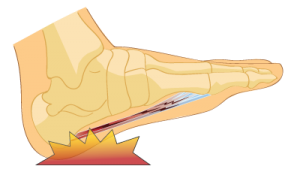What is Plantar Fasciosis?
Plantar Fasciosis (also known as Plantar Fasciopathy) occurs when the plantar fascia tissue begins to degenerate where it attaches to the heel bone. Generally, it’s thought to be an advanced form of Plantar Fasciitis. If you have severe Plantar Fasciitis that is left untreated or improperly treated, your plantar fascia will start to develop microtears.
The difference between Plantar Fasciosis and Plantar Fasciitis is that there is no inflammation present with Plantar Fasciosis, while there is usually a lot of inflammation with Plantar Fasciitis.
Causes of Plantar Fasciosis
The causes of Plantar Fasciosis are similar to those of Plantar Fasciitis. These include:
- Improper footwear
- Weight gain
- Accelerated level of physical activity
- Flat feet
- Plus more…
Symptoms of Plantar Fasciosis
The most obvious symptom of Plantar Fasciosis is heel pain, which is usually most extreme after taking the first few steps of the day. You may also find that your heel pain is worse after standing or sitting for long periods of time.
Since Plantar Fasciosis does not involve inflammation, there should be no redness or swelling in the area of injury.
Treatments for Plantar Fasciosis
The number one most effective treatment for Plantar Fasciosis is proper footwear. Shoes that are too tight, too loose or that don’t have sufficient arch support are known to cause foot pain and other foot issues.
Heat is another treatment method that may help. Heat can help provide therapeutic relief of your pain. It also promotes the stimulation of oxygenated blood flow, which works to heal tissue damage.
Another important thing to do is rest. Your foot has gone through a lot of stress, so preventing further damage to your plantar fascia is key until you’re further along in the healing process.